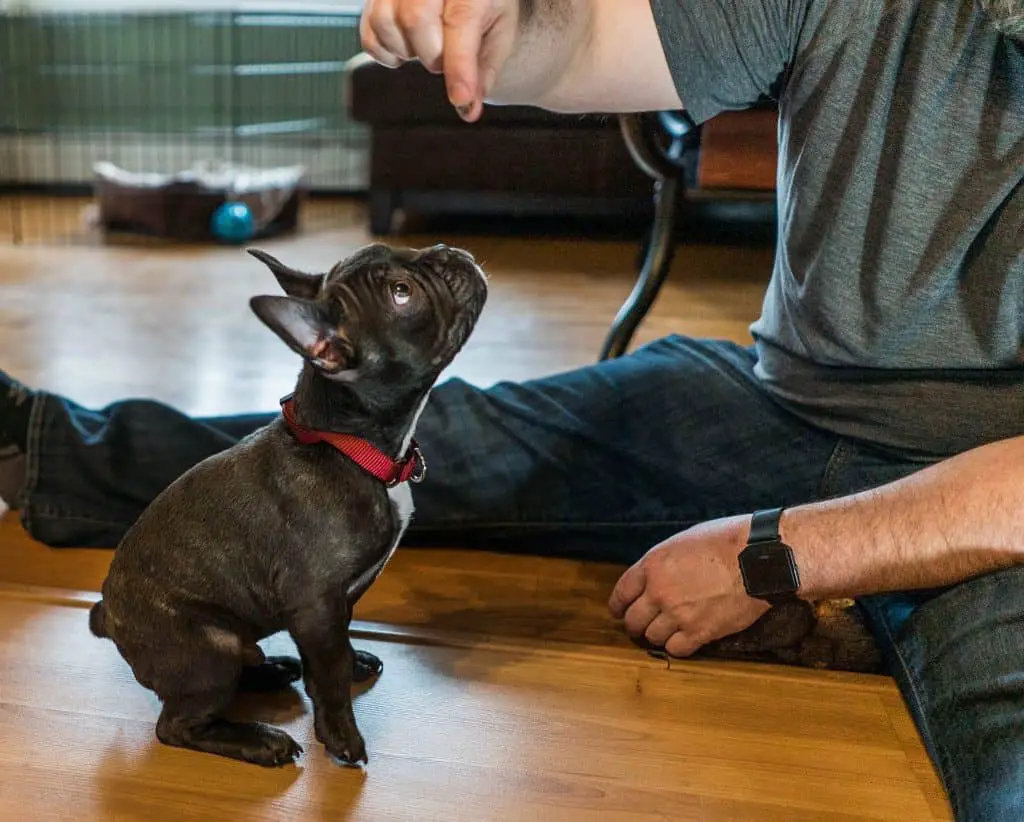French bulldogs are a sweet, affectionate breed. However, any dog can be shy around people, and some may need time to get comfortable around you. Learning more about canine body language and understanding how to calm down a dog, along with a little patience, is the best way to get a Frenchie to show you some love and attention.
French Bulldog Personalities
Small enough to cuddle in your lap, yet larger than the average Chihuahua, Frenchies are lovable goofs that give just as much affection as they get. They’re also typically calm dogs that are playful, food-driven, and curious. While easy to train, this breed does have a stubborn streak.
Like all dogs, French bulldogs can be shy or wary around people they don’t know. Conducting a puppy temperament test can clue you in on some behaviors early on, but poorly socialized or abused rescues, pups with separation anxiety, and timid Frenchies left alone with a pet sitter for the first time can exhibit signs of fear that may escalate.
Fearful, Shy Canine Body Language and Behavior
Most dogs, including Frenchies, try their best to signal emotions like fear or anxiety through body language long before shifting to aggression and self-defense. Unfortunately, most people don’t catch or know how to interpret these signs, and situations can quickly get out of hand.
A dog that is shy, uncomfortable, or fearful will exhibit the following body language:
- Low Profile: Calm dogs have a relaxed upright posture with perked up ears and eyes that are bright and alert. Timid or shy pups will attempt to make themselves smaller when feeling threatened. They may cower, tuck their tails, and flatten their ears when they’re unsure or afraid.
- Licking or Panting: French bulldogs and other breeds will repeatedly lick their lips or pant when they’re nervous or anxious. When there’s no temperature or exercise trigger for panting, or if a dog is licking its lips over and over without eating or drinking, it’s a good bet that your pup is under stress.
- No Eye Contact: When a dog refuses to look at you, they’re usually feeling shy, scared, or intimidated. Hypervigilance without eye contact, indicated by their gaze shifting rapidly from side to side, is a sign of a dog desperately looking for an escape route.
- Whale Eye: A stressed-out pup will often display the whites of its eyes at the inner or outer corner when it’s feeling overwhelmed. French bulldogs and other short muzzle breeds naturally show a bit of white in their eyes due to their features, so whale eye might not be as obvious as other signs of fear or stress.
- Yawning: This aspect of a dog’s body language is probably the one most people miss. But, it’s true; a response we associate with relaxation is a canine response to a threat. It’s a dog’s way to de-escalate a scary situation and avoid conflict. Of course, context is everything. Yawning after a nap and yawning during a vet visit are two entirely different things.
- Whining and Pacing: Agitated whining, quick pacing, a stiff posture, and raised hackles indicate a dog in distress that’s preparing to defend itself. At this point, tension is high, and it won’t take much to tip this behavior into hostility.
Missing or ignoring signs of canine shyness or discomfort can push dogs, even friendly breeds like Frenchies, into aggressive behavior. Once they pass that threshold, scared dogs go on the defensive by barking, lunging, growling and even biting.
Approaching Shy Dogs and Handling Fearful Behavior
Understanding how to calm down a dog once you see signs of fear, shyness, or anxiety will help you gain the trust of your beloved Frenchie. Forcing scared dogs to endure uncomfortable situations just makes things worse. Also, you should never punish a pup for showing signs of stress. Use these indicators as opportunities to effectively manage and train your fearful dog.
Follow the ten tips below to get a scared or shy French bulldog to warm up to you in a way that’s positive and safe for everyone, canines and humans included:
Stay Calm and Confident
It’s natural to be a little scared of a dog that’s acting aggressively. However, a calm, cool demeanor can help you avoid an attack or encourage hostile behavior. If you feel anxious or need to leave the area, don’t make sudden movements. Stay calm and still for a short time before slowly moving away.
Give Them Your Good Side
Shy dogs may bark and snap when they feel threatened. A person looming over them head-on can be very scary. Put a timid Frenchie at ease by turning sideways and keeping gestures and movements slow and relaxed to appear less intimidating. It’s a good idea to teach kids to do this when approaching dogs, too.
Avoid Direct Eye Contact
While people associate eye contact with honesty and openness, fearful dogs view a stranger’s direct gaze as a threat. Look away or to the side when dealing with pups that seem shy or uncomfortable to let them know you don’t mean them any harm.
Give Them Space
Fearful Frenchies may need to retreat to feel safe. Work with a scared dog in a room that’s large enough for them to escape or hide if they’re uncomfortable. Including a familiar den-like crate and other hideaways gives them time to regroup and investigate on their own terms.
Take it Slow
A scared dog may see quick movements as angry or violent. Quiet gestures and easy, slow strides convey the message that you’re relaxed, approachable, and predictable. Take special care when sitting or kneeling on the floor, as sudden, unusual movements can undo your previous progress.
Get on Their Level

Tall, looming humans can frighten any pup, which goes double for smaller breeds like French bulldogs. If a scared dog shows signs of discomfort, but not hostility, try kneeling, crouching, or sitting on the floor to level the playing field. Remember to stay at a safe distance and avoid putting your face too close to theirs, just in case.
Let Fearful Frenchies Make the First Move
It’s hard not to swoop in and make a fuss over a sweet shy French bulldog. The struggle is real. But, it’s best to hang back when dealing with a scared dog and let them approach you on their own terms. Give them the time and space to get comfortable and curious about you. If their body language is relaxed and friendly, try a treat or a little gentle affection once they’re within arm’s reach.
Reinforce Good Behaviors
Tossing treats at a fearful, barking Frenchie might seem like a smart shortcut, but rewarding bad behavior encourages an encore performance. Instead, give treats to pups when they are calm, if they get closer to you on their own, and when they approach you for head scratches. Reward the behavior you want to see, and you’ll see it much more often.
Walk it Off
When your shy French bulldog is feeling more confident around you, try a walk. Taking a turn or two around the block builds trust and helps you bond with your pup. Keep an eye out for anxious or fearful canine body language cues when clipping your leash to your dog’s collar or harness. Be ready to back off and try later if you see your dog yawning, licking, or avoiding eye contact.
Create a Comfortable Environment
When training a scared dog, provide them with places to go when they’re feeling overwhelmed. Consider a soft pet bed or two on the floor, a bin full of toys, and a cozy crate that you can use to comfort, distract, and train a timid Frenchie. In anticipation of long cuddle sessions or naps on the sofa, look for the best couch for dogs to share with your future binge-watch buddy.
Stay the Course
While scared or shy dogs may take a few weeks of work and patience, the payoff far exceeds the price. French bulldogs are a wonderfully trainable breed, so most timid pups warm up to new people quickly. Understanding canine body language and knowing how to calm a scared dog, along with plenty of treats, will help you connect, build trust, and improve your pup’s confidence in no time.
PS – Looking for more ways to socialize your French Bulldog? I have personally found that doggy daycare is a great option to help your Frenchie.



